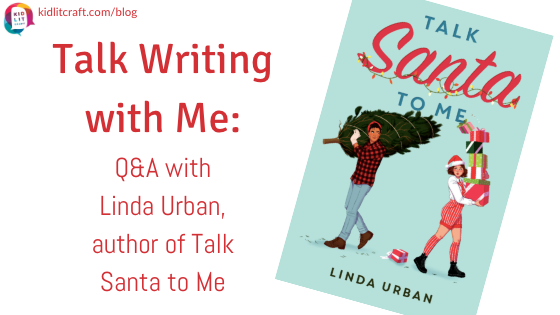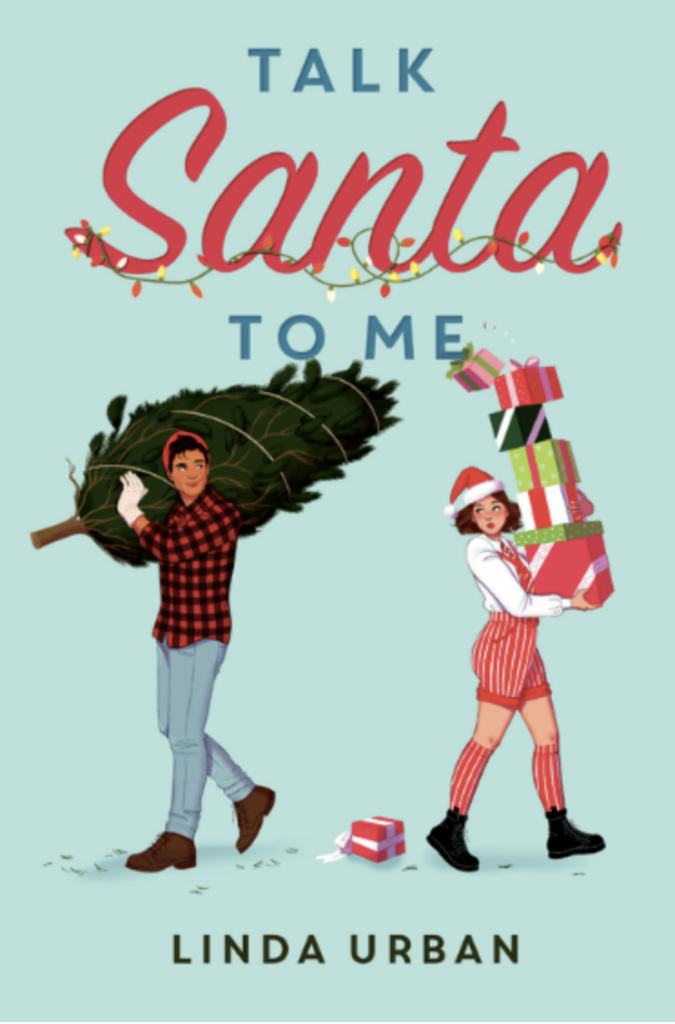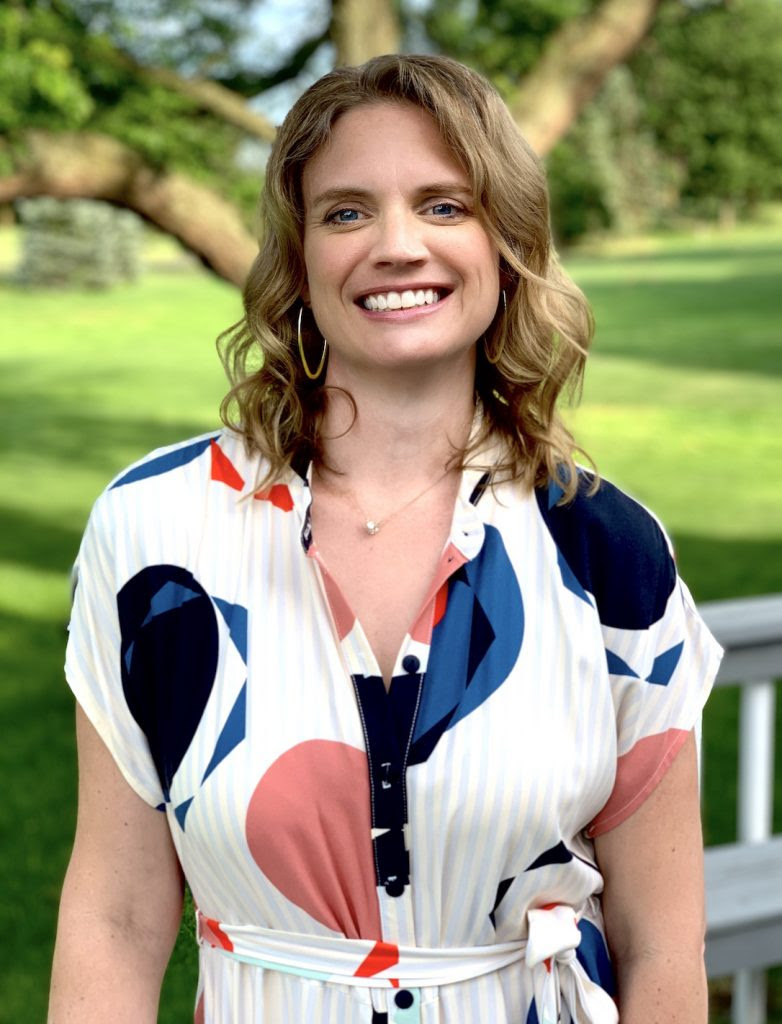interview by Erin Nuttall
The first time I heard Linda Urban speak about writing for children her enthusiasm and energy were infectious. Her kindness, compassion, and care for her reader were evident. Then I read her stories, and I found all of those qualities and more. I especially enjoy the realistic way she weaves anxiety and humor together. Linda knows her audience. She knows their hurts and dreams. Her stories help her readers make sense of their world. I’m always ready to learn from Linda. –Erin
KidLit Craft: You’re known for funny, poignant MG. What inspired you to jump into YA and write Talk Santa to Me?
Linda Urban: Well, I didn’t really jump into YA. I was kind of jumping all over the place and landed there. After attending the Charles W. Howard Santa Claus School in Midland, Michigan, I tried writing a picture book about it. I actually like the picture book a lot, and a few editors did, too. But every time the manuscript got to an acquisitions meeting the response was the same: Parents are not going to buy a book that suggests that there is no real Santa. (I should say that I did not for one second suggest that, but rather that Santa has a lot of helpers who go to school to learn how to do the job almost as well as he does. Still. No dice.)
I also talked with Jeannette Larson, my editor at HMH about it and its potential as a middle grade novel. Jeannette reminded me that some of my middle grade readers were as young as eight or nine. A novel with a Santa School thread would face the same problem as the picture book.
And so, Young Adult.
I should say, though, that this is a very young YA.
KLC: What are some craft differences between writing MG and YA?
LU: I’m hardly an expert. For me it really comes down to respecting the reader enough to fully invest in the character. There are middle graders dealing with things that we often think of as YA topics, and juniors in high school still sorting out the things that we think about as middle grade.
My feeling is that if we are true to where our particular characters are developmentally, experientially, and philosophically, and we write from that place, we can write work that will connect with readers.
The thing is, Middle Grade and Young Adult are marketing categories developed by publishers. They matter because they help publishers sell books and find readers. But the books themselves, the stories, have to find their own truth first. Maybe that is naive, but it is how I feel about it.
KLC: How does sidewriting fit into your drafting process?
LU: This varies with every project. Right now I’m working on a young adult project that some might think is nothing but sidewriting. Lots of vignettes from various points of view. Many won’t make it into the final work, and I suppose those might later be considered sidewriting.
My best work happens when I’m open to play and not holding too tightly to any predetermined narrative. If I can believe that any day’s writing is valuable sidewriting, I often make more actual progress than I otherwise would.
KLC: Francie, the protagonist in Talk Santa to Me, is witty and funny (especially in her internal dialogue). How did you keep her from being snarky?
LU: Aw, thanks! I think that as funny as she is, she is also earnest and vulnerable. She has a deep love for her family and her friends, and she’s okay with them knowing that. Snark is a defense mechanism. Her snarkiest moments are in response to people/things she feels she needs to defend herself against–her aunt, her aunt’s intern, the boys at school–but she’s not at all defensive about the things that matter most to her, and so that keeps her just this side of snarky, I think.
KLC: Talk Santa to Me has some great dialogue and banter. How would you advise someone looking to do the same in their writing?
LU: Thanks again! I should do more interviews like this. It’s great for the ego.
Would it surprise you if I said that it all comes back to character? One of the best ways that I can communicate that two characters are comfortable with each other and/or that they have a history is by allowing them to be playful in their dialogue. If you look at characters like Francie and Alice you can see the trust between them. Alice can try out terrible accents and not worry a whit about being judged. Francie can talk honestly and playfully about the holiday shop in the same way. Neither of them talks that way with people they don’t know or trust.
That said, banter can also be a mode of self-protection, too. We see that a lot in romantic comedies–people wanting to connect, but also using humor to keep some distance. I haven’t written a character like that yet, but I’d love to.
If I had to give advice, I’d recommend eavesdropping for a while. I’ve heard that advice given as a way to pick up “the way teenagers talk” or “current slang”–but I think that is terrible advice. What I’m recommending is listening for clues to relationships by paying attention to what goes unsaid. See if you can figure out how long the people speaking have known each other and how comfortable they are with each other. What do they leave out? What shorthand do they use? How much of their language seems to refer to other conversations or experiences they’ve shared in the past? How much is their conversation about conveying actual information, and how much seems to really be there just as a way to say I know you. I like you. I know you like me. We’ve got each other’s backs, right? Or the opposite.
When we write, our dialogue usually has to do the “conveying actual information” part, but really good dialogue is also a way to assert the relationship stuff, too.
KLC: Writing a genre book requires its own conventions. Did you find those requirements freeing or restricting?
LU: I’m not sure that I really wrote a genre book, actually. It was marketed as a rom-com, but I’d really argue that it is a comedy with a romance thread.
KLC: How does your background in marketing books influence your writing?
LU: I think it gives me more realistic expectations for how a book might do once it is published. Before that point, though, I try to keep my marketing experience out of the picture entirely.
KLC: What’s next on the horizon for your fans?
LU: I’ve got a picture book coming out next year that I am really excited about called Once She Knit a Yellow Dress. Keith Henry Brown is illustrating, and it is going to be gorgeous. Like so many of my books, it is about listening and honoring moments of connection.

Linda Urban writes picture books, chapter books, middle grade, and young adult novels. Her books have appeared on more than 25 state reading lists, as well as best books lists from The New York Public Library, Kirkus, the National Council of Teachers of English, and IndieNext. Linda has a BA in Journalism and an MA in English from Wayne State University in Detroit and pursued further graduate study in Film and Television Critical Studies at UCLA. For ten years, she served as marketing director at Vroman’s Bookstore in Pasadena, California. And is currently faculty at Vermont College of Fine Arts. You can find her at www.lindaurbanbooks.com and on Instagram @linda.urban.books
To order a signed copy any of her books contact my local indie bookstore, Bear Pond Books, and leave a message in the Order Comments box. Be sure to tell Linda if you’d like the book signed to someone in particular!
For more YA author Q&As, check out these posts!
Erin Nuttall holds an MFA in Writing for Children and Young Adults from Vermont College of Fine Arts and is an active member of SCBWI and ALAN. She lives outside of Chicago with her family where she writes stories for middle grade and young adult readers that offer a humorous take on friendship, identity, feminism, and romance.



COMMENTs:
0